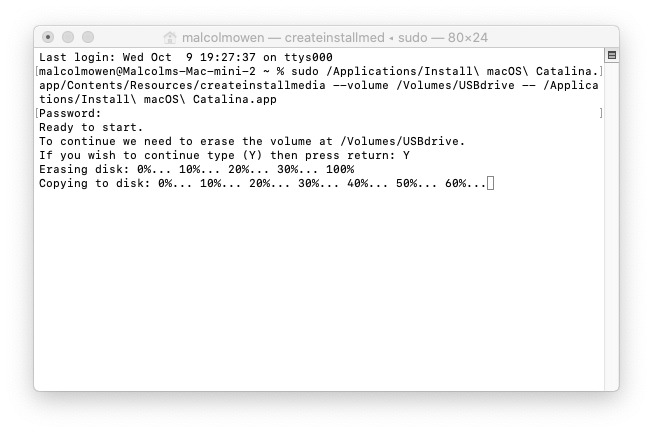

- #MACOS CATALINA BOOTABLE USB MAC OS#
- #MACOS CATALINA BOOTABLE USB INSTALL#
- #MACOS CATALINA BOOTABLE USB UPGRADE#
Make a USB thumb drive installer that you can plug into your computer to upgrade it.Take your computer into the nearest Apple Store and they will do the upgrade for you.
#MACOS CATALINA BOOTABLE USB INSTALL#
Download the Installer from Apple directly to the computer that you want to install the new OS X onto.This means if you have any version of OS X newer than 10.9 then you can upgrade it to the latest version for free. requirements.Since OS-X Mavericks (10.9) Apple have been releasing their OS X upgrades for free. SP742 - macOS Sierra 10.12 - Technical Spec. SP765 - macOS High Sierra 10.13- Technical Spec. SP777 - macOS Mojave 10.14 - Technical Spec. SP803 - macOS Catalina 10.15 - Technical Spec. HT212551 - macOS Monterey 12 - compatibility.

HT201372 - Create a bootable installer for macOS. Sw_vers - Print macOS operating system version. The target system will require 26 GB to 44 GB of free space for an installer to run. The macOS Startup Manager will then appear and you can select a startup drive. To boot from an alternate drive restart your Mac while holding down the Option key. The build process can take 20 minutes or so to complete, wait for the 'Done' message If you see the message “ To continue we need to erase the disk at /Volumes/Untitled.” Type the letter Y and press Return. Sudo /Applications/Install\ macOS\ Sierra.app/Contents/Resources/createinstallmedia -volume /Volumes/Untitled -applicationpath /Applications/Install\ macOS\ Sierra.app -nointeraction

Sudo /Applications/Install\ macOS\ High\ High Sierra.app/Contents/Resources/createinstallmedia -volume /Volumes/Untitled -applicationpath /Applications/Install\ macOS\ High\ Sierra.app -nointeraction Sudo /Applications/Install\ macOS\ Mojave.app/Contents/Resources/createinstallmedia -volume /Volumes/Untitled -applicationpath /Applications/Install\ macOS\ Mojave.app -nointeraction Sudo /Applications/Install\ macOS\ Catalina.app/Contents/Resources/createinstallmedia -volume /Volumes/Untitled -applicationpath /Applications/Install\ macOS\ Catalina.app -nointeraction Sudo /Applications/Install\ macOS\ Monterey.app/Contents/Resources/createinstallmedia -volume /Volumes/MyVolume Becasue we are using sudo you will be prompted for a password: Open the terminal and copy one of the following, single line commands. The program used to create a bootable drive ( createinstallmedia) is supplied as part of the installer App. You could name the drive to something different as long as you adjust the command line syntax below to match. The Terminal commands below assume that the drive is named Untitled. Name the drive ' Untitled' this name will be changed when the new volume is initialised.
#MACOS CATALINA BOOTABLE USB MAC OS#
The drive must be formatted as a Mac OS Extended (Journaled) volume with a GUID Partition Table. This can be a hard drive, an SSD, or a USB stick. You need a Mac-formatted drive big enough to hold the installer and its data - 12 GiB. Then copy the installer App somewhere else so that you won't have to download it again.Īt the command line, spaces must be escaped so these become:

Therefore your first step after downloading the installer should be to cancel the install. If you run the macOS installer from the /Applications folder, the installer app will be deleted. MacOS is distributed through the App Store which will download an installer app to the /Applications folder. Use a USB flash drive (or other removable media) as a startup disk from which to install macOS.


 0 kommentar(er)
0 kommentar(er)
